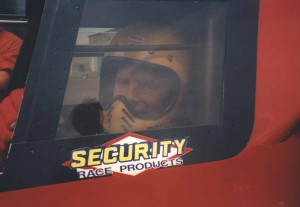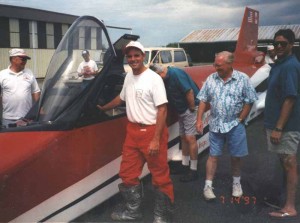300 mph in 3.5 seconds: What a rush
Let the record reflect I wasn’t crying when they sealed up the cockpit, no matter what the crew says. My eyeballs were sweating, is all. First they put me in a flame-retardant suit (not flame-proof, let’s be clear about that), then they cinched me into the cockpit and THEN they handed me the release form, so they’d know where to Fed-Ex the pieces should the car decide to become an aircraft.
So how did I wind up in a needle-like car powered by an engine that used to belong to an F-4 fighter? Marketing, baby. It’s a beautiful thing. It started with a group of backyard hot-rodders from Washington State. They were sitting around one day and somebody started talking about the land speed record. And they laughed. And then they talked some more. Pretty soon they were drawing pictures on napkins. Then the military surplus engine came in. All of a sudden, between sips of Bud, they were saying, “Hey, this might just work.”
How to wangle a ride: smoke and mirrors
Racing takes money. Money comes from sponsors. When you’re building a car, what you’re really racing for is sponsorships – and publicity. To that end, this group of hot-rodders came up with an idea I loved: A second seat, so they could take sponsors and media types for rides. When I read that a land-speed-record team was going to take reporters for rides if they had a legit publisher, I did what any good magazine writer would do. I faked it. I called the racing team and told them Maxim Magazine wanted the story, which wasn’t exactly precisely true. The truth was that Maxim didn’t know anything about it … until I called and told them I had a just talked myself into what might julietta casino online turn out to be the fastest car in the world. If Maxim wanted the story, they had to deal with me – or so I claimed. When Maxim said yes, I had just bluffed my way into the ride of my life.
After flying 3,000 miles and sleeping in my rental car, I watched them roll the 40-foot car out of the trailer on a quiet Sunday morning. The first thing I wondered was, “How the hell are they going to keep that thing on the ground?” The answer was … well, they weren’t sure. They were just nudging it ahead, going a little faster every time, hoping for the best. Turned out they hadn’t done any fancy wind tunnel model testing (no money for that) but that didn’t seem to worry them. “You build it horizontally stable and vertically stable and that’s it, pretty much,” said Rick Kikes, the car’s designer. “You don’t want to overcomplicate things.”
A grandfather at the wheel
At that point I started wondering if Kikes and the others just drew it up in the dirt with a Popsicle stick before firing up the welding machine. But they were more sophisticated than that and plenty experienced. The car, called the North American Eagle, was the seventh jet car built by Kikes. (I was afraid to ask what happened to the other six). The driver, Les Shockley, was a semi-retired grandfather of five who probably logged more jet-car runs than anybody in the world.
48,000 horsepower: Do not get in our way
Their previous “low speed” test runs had been going well, taking them up to 250 to 300 mph. The impressive part was the acceleration, which was about the same as a top-fuel dragster for the first second or two. But when the afterburner was lit, the car was even faster than a top-fueler. On afterburner its General Electric J-79 engine developed about 48,000 horsepower. A top-fueler might put out about 5,000. Clearly, adding a second seat and the weight of a passenger wasn’t going to make a critical difference, except maybe to hold the car down for another millisecond.
For the world speed record, Kikes figured it would take a burn of about 15 seconds, pushing the car to about 700 miles per hour – not far from the speed of sound (about 760 mph at sea level with a temperature of 59F, slightly higher if it’s warmer). Many engineers believed that if a car did manage to hit Mach 1, the shock waves it created would bounce the car off the ground. I was happy to know Pop-Pop was only going to keep the throttle on for less than 4 seconds.
A launch I’ll never forget
Once the car was in place at the starting line, Grandpa Shockley and I suited up and climbed in. The runway, an old airstrip in a remote part of Washington State, looked incredibly short to me – more like a drag strip. When they lit the engine, my adrenaline synched right up to it. It’s a creepy noise, that jet whine. I’m used to the sound of race-tuned piston engines, lumpy and sputtery at idle. A jet engine just whines smoothly. When Shockley gradually added throttle, the pitch of the whine edged higher, becoming a shriek. Inside the engine, the turbine blades were sucking in oxygen and mashing it, mixing it with kerosene to be lit. The car was straining against its brakes, and as Grandpa added more throttle the shrieking became demonic. That’s the only way to describe it.
Then Shockley lit the afterburner. What happens when you do this is simple and about as subtle as a fist hitting your face. Gallons of kerosene are pumped into the back of the engine, where it explodes. That’s all an afterburner is, a controlled, continuous explosion, consuming about 10 gallons every second. Inside the car, the Gs nailed my arms in place. My face contorted like in those old videos of the early astronauts. It felt like somebody big had put their boot on my chest and was pushing, hard. The airstrip moved by so fast I couldn’t focus. Then the boot switched to my back. Shockley had shut the engine down and deployed the parachute. The end of the airstrip and the grass beyond it came up fast.
Again, please?
When they lifted the canopy, all I could do was wonder if my organs had moved. Kikes smiled. “It’s a big, bad boy,” he said. No, I said, it’s better than that. It’s a friggin’ beast. I wanted one.
(The North American Eagle team continued testing and was ready for an assault on the land speed record when they learned that a British car, driven by an RAF pilot, had gone 763 mph in Nevada’s Black Rock desert. Because their car was designed only to approach the speed of sound, they gave up on the record and put the car to work doing demonstrations at drag strips. Only one other member of the media got a ride. He’s a motorhead you may know: Jay Leno).



